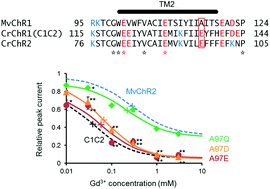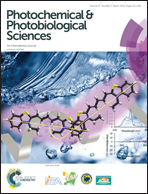The regulatory mechanism of ion permeation through a channelrhodopsin derived from Mesostigma viride (MvChR1)†
Abstract
The five glutamate (E) residues of transmembrane (TM)-2 of channelrhodopsin (CrChR)-2 are conserved among several members of the ChR family. A point mutation of one of them, E97, to a nonpolar alanine (E97A) reduced the photocurrent amplitude without influencing other photocurrent properties. The charge at this position is also the determinant of the Gd3+-dependent block of the channel. It has thus been suggested that E97 interacts with hydrated cations to facilitate their permeation and that these residues are the primary binding sites of Gd3+. However, the counterpart of this position is alanine for MvChR1 from Mesostigma viride. Here we investigated the ion permeation and the Gd3+-dependent channel block of MvChR1. We found that the high-affinity binding site of Gd3+ was absent in MvChR1, but was dependent on the negativity at this position. However, the ion permeation through the channel was markedly interfered with a negative charge at this position. Based on these findings, it is proposed that the ions can pass through the pore with minimal interaction with this position.

- This article is part of the themed collection: 16th International Conference on Retinal Proteins

 Please wait while we load your content...
Please wait while we load your content...